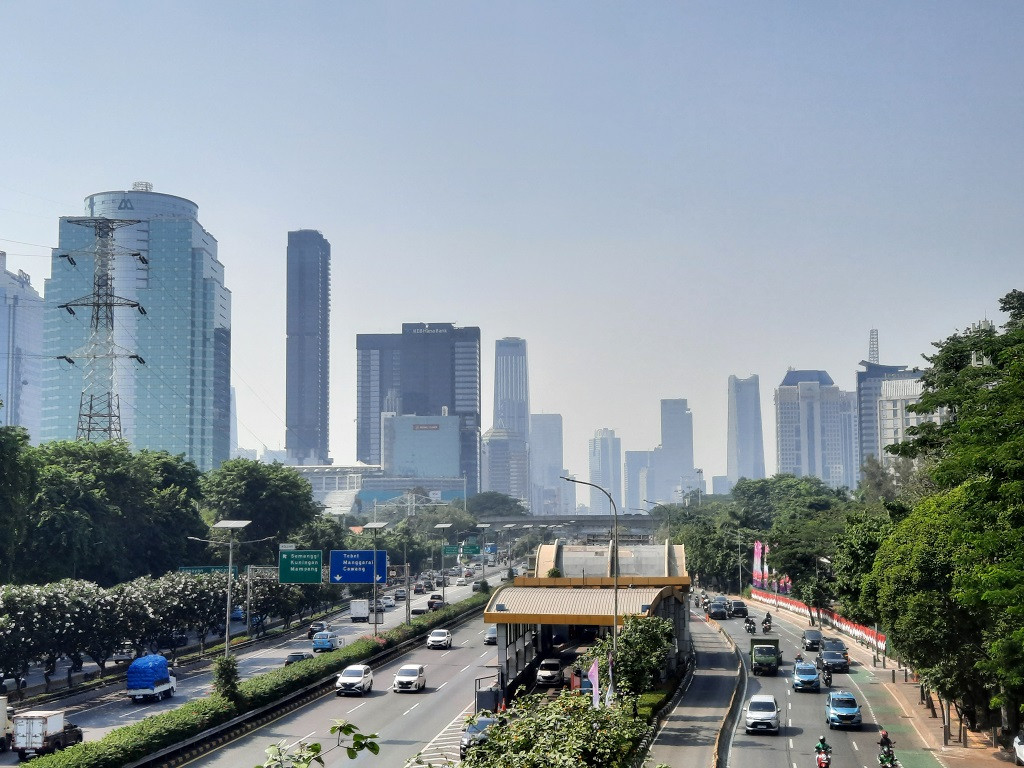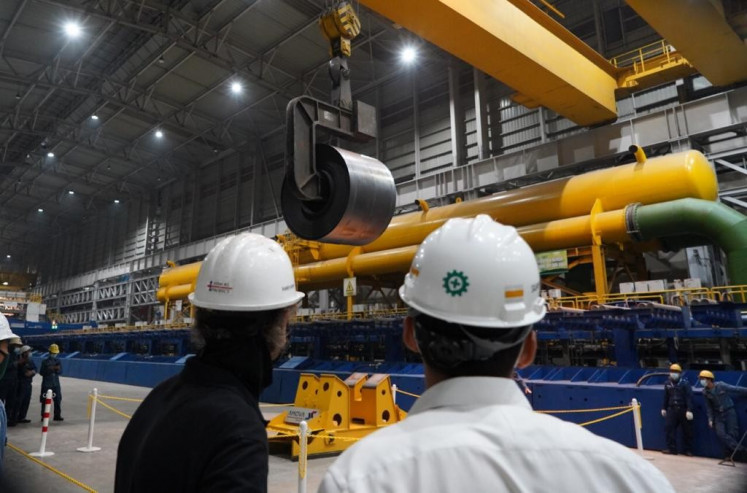Popular Reads
Top Results
Can't find what you're looking for?
View all search resultsPopular Reads
Top Results
Can't find what you're looking for?
View all search resultsJakarta’s pollution and China's new map haunt ASEAN Summit
The release of the new map on Aug. 28 did not create any new developments, but the timing is more of a concern.
Change text size
Gift Premium Articles
to Anyone
 Haze caused by air pollution shrouds skyscrapers in Jakarta on Sept. 5, 2023 morning, as seen from the vicinity of the Jakarta Convention Center (JCC) in South Jakarta. Jakarta is hosting the 43rd ASEAN Summit where leaders of the bloc and its dialogue partners are convening for high-level meetings from Sept. 5 to 7. (JP/A. Muh. Ibnu Aqil)
Haze caused by air pollution shrouds skyscrapers in Jakarta on Sept. 5, 2023 morning, as seen from the vicinity of the Jakarta Convention Center (JCC) in South Jakarta. Jakarta is hosting the 43rd ASEAN Summit where leaders of the bloc and its dialogue partners are convening for high-level meetings from Sept. 5 to 7. (JP/A. Muh. Ibnu Aqil)
T
he 2023 edition of the Chinese government’s official map of the country, released just one week before Indonesia hosts the ASEAN Summit in Jakarta, lays claim to the South China Sea and the disputed border area between China and India, creating an embarrassment for President Joko "Jokowi" Widodo. On top of that, as host, he should apologize to his guests, including Premier Li Qiang, as they will not breathe fresh air during their stay in Jakarta.
But before continuing this discussion, let me raise a statement from a Chinese economist on the strategic importance of ASEAN for China, which to me is incomplete. While economically ASEAN is very dependent on China, regarding geopolitical security and military cooperation, the 10 ASEAN member states prefer to look elsewhere, particularly the United States and the West, because China is still seen as scary.
Zheng Yongnan, the Chinese economist, recently said China must step up its economic fight against the US in the key battlefield of ASEAN and that China should do more to bring the regional group within its economic gravity because ASEAN has surpassed the US and European Union to become China's top trading partner.
"China must cement closer ties with its Southeast Asian neighbors, with the market of over 600 million inhabitants having turned into a key battlefield to build regional influence and economic supremacy over the United States," the South China Morning Post quoted Zheng as saying recently.
Zheng has been advising Beijing's policymakers after two decades of research on China's rise on the global stage, according to the Hong Kong newspaper.
ASEAN members need China, but they are not without reservations. The release of the new map on Aug. 28 did not create any new developments, but the timing is more of a concern. When the Chinese premier meets with ASEAN leaders this week, they may issue neutral statements, but distrust between the two sides will increase.
As the host, Jakarta has to accept the humiliating fact that the capital is among the world's most polluted cities now. The guests should brace for poor air quality, which has sickened the President himself. He can hardly find excuses for the air pollution, although the problem may justify his plan to relocate the capital city to East Kalimantan.
Then, there is the map issue, which only complicates the matter for Jokowi.
Beijing insisted the map release was just a matter of routine, but it is impossible to believe that the timing of the publication ahead of the ASEAN Summit was just a coincidence. China's calculated act demonstrates its determination not to back down from its claim that the map is based on facts.
The map could sour the mood and atmosphere of the multilateral summit, which is meant to find a peaceful solution to the overlapping claims to the South China Sea. Within ASEAN, Malaysia, Vietnam, the Philippines and Brunei have claims overlapping with China’s, and only Brunei has been mute on the issue.
Indonesia is not a claimant. Still, China has included the Natuna waters in its nine-dash line, arguing that Chinese fishermen have been fishing in the Indonesian waters for thousands of years. Backed up by the Chinese coast guard, Chinese fishermen have often clashed with Indonesian fishermen in the sea. President Jokowi has repeatedly insisted that Indonesia will defend its sovereign right over its exclusive economic zone (EEZ) in accordance with international law.
Regarding China’s new map, Foreign Minister Retno LP Marsudi contested China’s argument.
"Any line drawn, any claim made, must follow the 1928 UNCLOS [the 1982 UN Convention on the Law of the Sea]," she said after attending a hearing of House of Representatives Commission I on Thursday.
"Indonesia's position is not new, but a position that has always been conveyed consistently," she added.
Similarly, Indian Prime Minister Narendra Modi must also swallow a bitter pill because India will host the Leaders’ Summit of the Group of 20, of which the US and China are members, just after the ASEAN Summit and East Asia Summit in Jakarta.
Modi faces more severe consequences of the map because it includes the territory where both Beijing and New Delhi have overlapping claims. Hopefully, there will be no new military clash between the two Asian giants. The map was released just after the bilateral meeting between Modi and Xi on the sidelines of the BRICS Summit in Johannesburg.
CNN reported that China published a new version of its national map on Aug. 28, as it has regularly done since at least 2006, to correct what Beijing has previously referred to as "problematic maps" that it claims misrepresent its territorial borders. The "standard map" was released by Beijing's state-owned newspaper, the Global Times. The map also showed Taiwan, India's northeastern state of Arunachal Pradesh and the Aksai Chin region as part of China's domain.
Indian External Affairs Minister Jaishankar Subhramanyam also dismissed China's claim in a television interview on Tuesday night. "We are very clear what our territories are. There should be no doubt about that. Just making absurd claims don't make other people's territory yours," he said, as quoted by Indian media.
As reported by the Manila Times, the Philippines also rejected the 2023 version of China's government map.
"This latest attempt to legitimize China's purported sovereignty and jurisdiction over Philippine features and maritime zones has no basis under international law, particularly the 1982 UNCLOS," said its Department of Foreign Affairs.
In 2016, the International Court of Arbitration, in its verdict on the request of the Philippines, stated that China had no legal grounds to claim the South China Sea.
Malaysia also issued a statement in response to the new map.
"Malaysia does not recognize China's claims in the South China Sea, as outlined in the 'China Standard Map 2023 Edition' which covers Malaysia's maritime area," the foreign ministry said in a statement.
Kuala Lumpur described the South China Sea issue as "complex and sensitive", stating the dispute must be "handled peacefully and rationally through dialogue" based on international law.
PM Li will meet ASEAN leaders in Jakarta this week, and President Xi will meet other G20 leaders in New Delhi this weekend. Can you expect the mutual trust among the countries to stay high after the map release?
So far ASEAN has limited choices. Jakarta’s pollution and China's new map will haunt the ASEAN Summit.
***
The writer is senior editor at The Jakarta Post.










